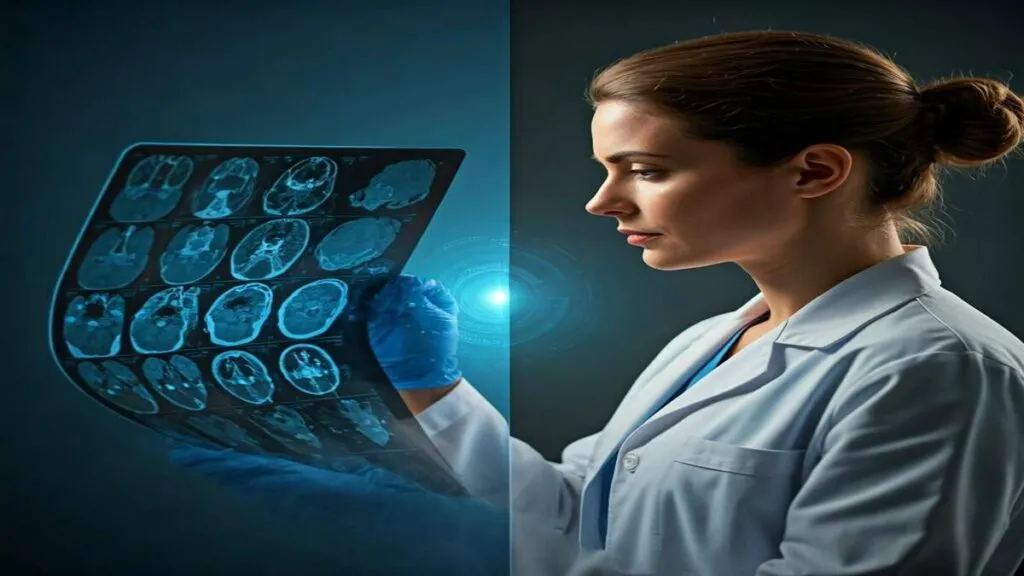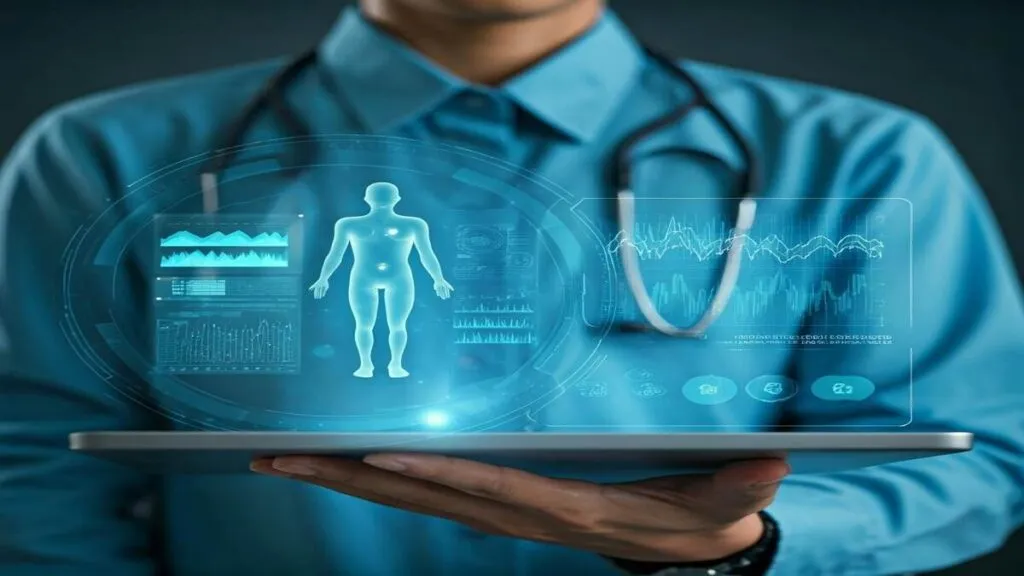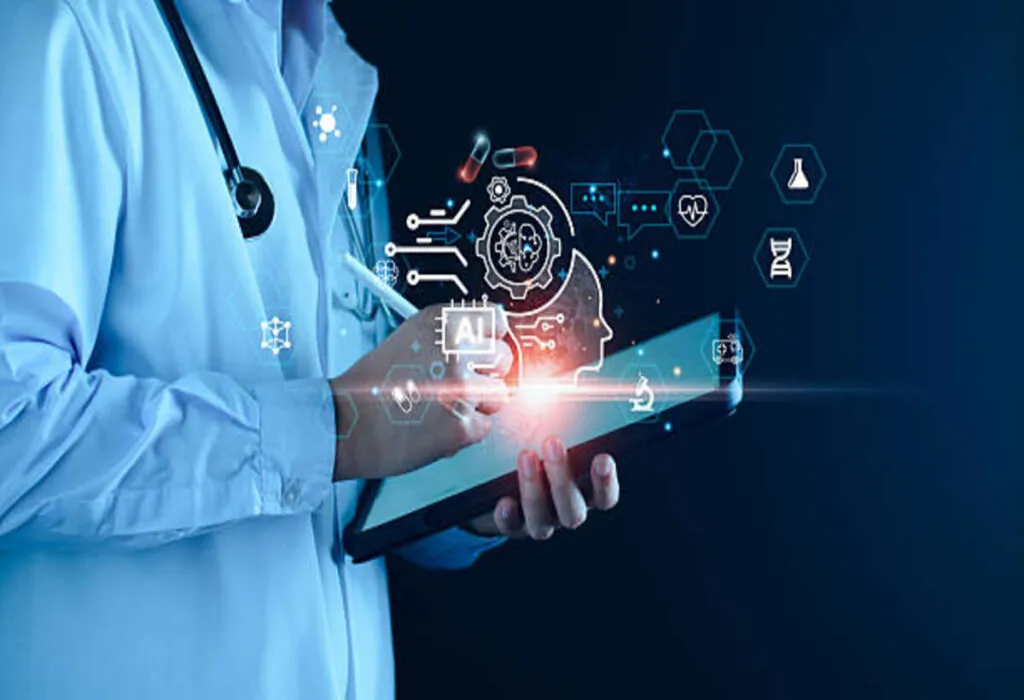
“AI won’t replace doctors, but doctors who use AI will replace those who don’t.” — Dr. Eric Topol.
Artificial Intelligence (AI) in healthcare diagnosis is no longer futuristic—it’s here and changing lives. From advanced hospitals to rural clinics, AI-powered tools are making diagnosis faster, more accurate, and more accessible. But how does AI work in medical diagnostics? Is it safe? Will it replace doctors—or empower them? Let’s explore everything you need to know about AI in healthcare diagnosis and why it’s shaping the future of medicine.
Contents
What Is AI in Healthcare Diagnosis?
Simply, AI in medical diagnosis refers to the application of technologies like
- Machine Learning (ML)
- Deep Learning (DL)
- Computer Vision
- Natural Language Processing (NLP)
These tools analyze large volumes of health data—such as:
- Clinical notes and prescriptions
- Lab results
- Electronic Health Records (EHRs)
- Medical images (X-rays, MRIs, CT scans)
- Genomic data
AI systems can assist physicians in the following ways by learning from thousands or even millions of previous cases:
- Early disease detection
- Quicker interpretation of test results
- Personalized treatment recommendations
Types of AI Used in Medical Diagnosis
- Machine Learning (ML): Learns from past data to predict future outcomes.
- Deep Learning (DL): Neural networks excel in complex imaging analysis.
- NLP: Interprets clinical notes and prescriptions for better diagnosis.
- Computer Vision: Scans medical images to detect tumors or fractures.
Explore also how AI fits into the big health tech picture: Top 10 Digital Health Trends in 2025
Key Benefits of AI in Healthcare Diagnosis
1. Speed and Efficiency
AI can review an MRI scan in seconds, flagging potential issues far quicker than traditional methods. This saves time in emergencies, like strokes or internal bleeding.
2. Increased Accuracy
AI reduces human error by comparing images and lab results with massive datasets.
Example: Google’s DeepMind developed an AI model that outperforms radiologists in detecting breast cancer.
3. Early Detection of Diseases
Predictive AI can detect illnesses such as Alzheimer’s, diabetic retinopathy, and some cancers early—even before symptoms occur.
4. Increased Accessibility
In areas without specialist doctors, mobile-based AI tools can help nurses and general practitioners make informed decisions. This is a game-changer for rural and underserved communities.
5. Personalized Medicine
By analyzing genetics, lifestyle, and health history, AI helps tailor diagnosis and treatment plans to each patient—not a “one-size-fits-all” approach.
How AI Improves Diagnostic Workflow
- Faster Triage: Urgent cases flagged instantly.
- Automated Reports: Generates draft reports for radiologists.
- Decision Support: Suggests next steps for doctors.
Want to upgrade your digital health skills? Read Best Online Courses for Health Professionals in 2025
Real-World Applications of AI in Healthcare Diagnosis
🧠 Neurology
IBM Watson assists doctors in diagnosing neurological conditions like Alzheimer’s and Parkinson’s using speech analysis and brain imaging.
❤️ Cardiology
AI tools can detect abnormalities in ECGs and even predict heart attacks before they happen.
🩻 Radiology
Startups like Aidoc and Zebra Medical Vision use AI to flag urgent cases in CT scans and X-rays.
👁️ Ophthalmology
Google’s AI can detect diabetic retinopathy with the same accuracy as a board-certified ophthalmologist—helping prevent blindness in diabetic patients.
🧬 Genomics & Rare Disease Diagnosis
AI can sift through genetic data to identify uncommon mutations that cause inherited diseases. This has great benefit in pediatrics and oncology.
AI + Telemedicine Integration

AI is making telemedicine smarter:
- AI Chatbots: Pre-screen patients before video consultations.
- Remote Monitoring: Tracks vitals with AI-driven alerts.
- Smart Alerts: Warns doctors about sudden health risks.
Learn also more about remote healthcare: Telemedicine in 2025: The Ultimate Guide
Case Study: AI in Healthcare Diagnosis for India’s TB Detection Program
In India, where tuberculosis (TB) remains a serious public health concern, the government collaborated with AI companies to scan chest X-rays using mobile vans equipped with AI software. The AI software instantly flags high-risk cases—reducing diagnostic delays and improving treatment access in remote areas.
Impact:
- 40% faster diagnosis rate
- Screening expanded to underserved districts
- Reduced burden on radiologists
Real-Life Impact of AI in Healthcare Diagnosis: A Story from the Frontline
Consider this: A 52-year-old woman in Kenya visits a rural clinic with blurred vision. There’s no ophthalmologist nearby, but the clinic uses an AI tool connected to a retinal scanner. Within minutes, the tool flags early-stage diabetic retinopathy. She’s referred for treatment before any permanent damage occurs.
Without AI? She might have lost her sight before anyone caught it.
AI and Patient Privacy Concerns
- Federated Learning: AI learns without transferring patient data.
- HIPAA & GDPR Compliance: Essential for global adoption.
- Encryption: Keeps sensitive health data secure.
Challenges Facing AI in Healthcare Diagnosis
Even though AI holds great promise, it is not perfect. Among the major challenges are:
🔍 Data Bias
If AI is trained on non-representative data (e.g., mostly from Western hospitals), it may misdiagnose patients from other regions or demographics.
❓ Interpretability
Many AI models are “black boxes”—they give results without explaining how. That’s a problem in healthcare, where doctors need to justify decisions.
⚖️ Ethical & Legal Risks
Who’s liable if an AI makes a wrong diagnosis? Legal frameworks are still evolving to address this.
🧩 Integration Issues
AI tools must blend into clinical workflows, not disrupt them. Doctors need tools that support—not slow down—their practice.
Cost Impact of AI in Diagnosis
- AI reduces imaging costs and avoids unnecessary tests.
- Example: A U.S. hospital saved 15% in diagnostic costs after AI adoption.
Top AI Diagnostic Tools in 2025
- Google DeepMind – Breast cancer detection
- IBM Watson Health – Oncology insights
- PathAI – Pathology diagnostics
- Aidoc – Radiology prioritization
See more health innovations here: The Best 15+ Wearable Health Devices of 2025.
The Future of AI in Healthcare Diagnosis

The next big shift? Predictive diagnostics—where AI flags potential risks before disease even begins.
- Wearables like smartwatches + AI can predict arrhythmias or stress levels.
- Federated learning models will protect patient privacy while using global data for better insights.
- Multi-modal AI will merge data from labs, imaging, genomics, and lifestyle to provide 360-degree health insights.
We’re heading toward a future where AI doesn’t just help treat illness—it helps prevent it.
Quick FAQs on AI in Healthcare Diagnosis
Q: Is AI safe to trust?
When used responsibly and combined with human oversight, AI can actually reduce errors, not increase them.
Q: Can AI work without internet in rural areas?
Yes—some AI tools are designed to work offline or on low-bandwidth systems, especially in low-resource settings.
Q: Will AI replace doctors?
No—but it will support them by making diagnosis faster, more accurate, and more personalized.
AI in diagnosis aims to enhance human care, not replace it. It’s about giving every doctor a powerful digital assistant. About helping patients in receiving responses more quickly. And about making sure even someone in a remote village gets the same diagnostic quality as someone in a top-tier hospital. We’re entering a new era—where technology and human compassion work hand in hand to build smarter, equitable, and more efficient healthcare systems.
References
- Topol, E. Deep Medicine: How Artificial Intelligence Can Make Healthcare Human Again. New York: Basic Books; 2019.
- Rajpurkar P, et al. AI in healthcare: The road to clinical impact. Nature Medicine. 2022;28(4):747-756.
- WHO. Artificial Intelligence in Health: Opportunities and Challenges.
Disclaimer: This article is for informational purposes only and does not replace professional medical advice, diagnosis, or treatment. Always consult a qualified healthcare provider for personal medical concerns.
💬 What are your thoughts on AI in healthcare? Would you trust an AI diagnosis? Share your opinion in the comments section below! Want more health tech insights like this? Thank you for reading — together, let’s build a smarter, healthier future.
Founder of My Health Tech Talk. He is a health informatics professional, researcher, and graduate assistant with a passion for digital health and innovation, medical tourism and health tips. Learn more about author and his mission on the About Us page


